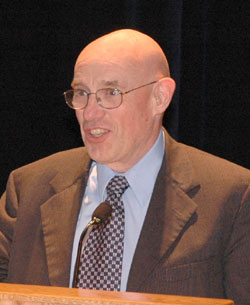 Dr. Henry L. Shands, the 2004 recipient of the William L. Brown Award for Excellence in Genetic Resources Conservation, has devoted more than 50 years of his life to various genetic resources programs—as a student, post-doctoral researcher, public and private plant breeder, and, for the past 18 years, as a senior administrator positions with the U.S. Department of Agriculture. He currently serves as the Director of the USDA-Agricultural Research Services’s National Center for Genetic Resources Preservation in Fort Collins, Colorado.
Dr. Henry L. Shands, the 2004 recipient of the William L. Brown Award for Excellence in Genetic Resources Conservation, has devoted more than 50 years of his life to various genetic resources programs—as a student, post-doctoral researcher, public and private plant breeder, and, for the past 18 years, as a senior administrator positions with the U.S. Department of Agriculture. He currently serves as the Director of the USDA-Agricultural Research Services’s National Center for Genetic Resources Preservation in Fort Collins, Colorado.
Dr. Shands is a world-renowned leader in plant genetic resource conservation. As National Program Leader and later as Assistant Administrator for the USDA-ARS, Dr. Shands provided critical leadership to the U.S. National Genetic Resources Program from 1986 until 2000. His accomplishments include forming an internationally recognized, coherent, and accountable system of germplasm sites to collect, evaluate, and distribute germplasm both within the U.S. and throughout the World. The establishment and refinement of the Germplasm Resources Information Network (GRIN) allows the exchange of information and resources in and orderly and timely manner. His leadership in establishing and coordinating the Latin American Maize Project (LAMP) gained global recognition for the project, which promotes cooperation among member countries, ensuring that valuable genetic resources are both documented and utilized by breeders around the world.
From 1989 to 1992, Dr. Shands served as the key contact from the USDA for the Department of State’s involvement in the international Biodiversity negotiations. In 1988, Dr. Shands was appointed Executive Secretary to the National Plant Genetic Resources Board and served from 1992 to 2000 in a similar capacity on the USDA’s National Genetic Resources Advisory Council, reporting directly to the Secretary of Agriculture. His international service on various committees includes: ex-officio member of Canada’s Expert Committee on Plant and Microbial Genetic Resources; panel chair, Consultative Group on International Agricultural Research (CGIAR) for the evaluation of its genetic resources program across all centers; program review committee member for several CGIAR centers to assess and upgrade their programs and advise the World Bank on funding initiatives; member of the Rural Development Department of the World Bank to assess genetic resources issues; and representative to the FAO Commission on Plant Genetic Resources.
In his current position as Director of the National Center for Genetic Resources Preservation, Dr. Shands has overseen the expansion of the mission of the Center to include animal genetic resources. The unique capability for cryogenic storage of both plant and animal materials is a showcase for all genebanks. While leading the National Germplasm System, Dr. Shands had the foresight to include cryogenic capability in the construction of the new NSSL in 1990. This has now come to full fruition with the addition of animal, and in the near future, insect and microbial germplasm.
Throughout his distinguished career, Dr. Shands has been an instigator of cooperation among various program units within the National Plant Germplasm System, as well as among USDA-ARS programs and various international germplasm programs (in India, China, Brazil, Russia, and elsewhere). His broad knowledge and expertise are unequalled, and his advice on all sorts of genetic resources questions is highly sought.
Previous honors given to Dr. Shands include the Frank N. Meyer Medal for Plant Genetic Resources, USDA Superior Service Award, American Seed Trade Association Presidential Distinguished Service Award, and the Distinguished Agricultural Alumni Award from Purdue University. He has also been named a Foreign Member of the Russian Academy of Agricultural Sciences, Fellow of the Crop Science Society of America, Fellow of the American Society of Agronomy, and Fellow of the American Association for the Advancement of Science.